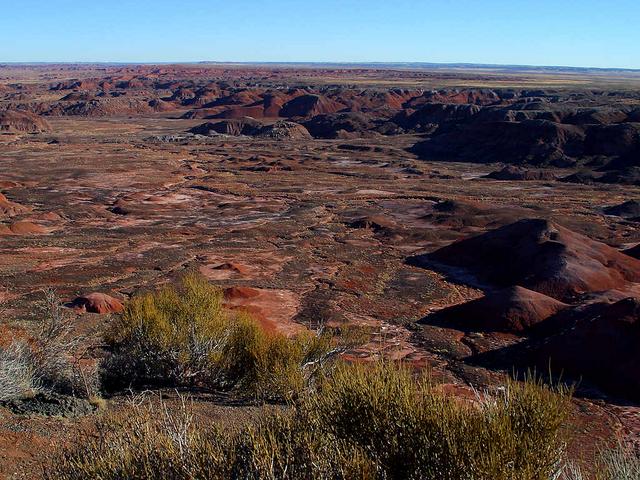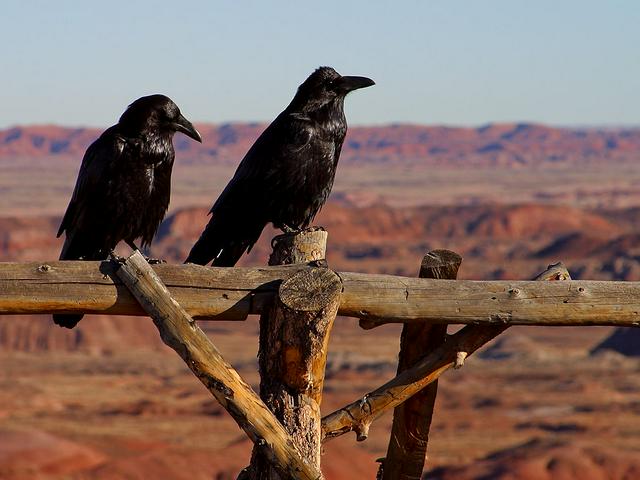Petrified Forest National Park is a United States National Park that is in eastern Arizona, in the Southwest region. The park takes its name from the remnants of ancient trees which have been transformed into brilliantly colored minerals through a series of geological processes.

Petrified Forest was set aside as a national monument in 1906 to preserve and protect the petrified wood for its scientific value. The monument became a national park in 1962, and legislation passed in 2004 more than doubled the park's area from 93,533 acres to 218,533 acres.
Petrified Forest National Park features one of the world's largest and most colorful concentrations of petrified wood, the multi-hued badlands of the Chinle Formation known as the Painted Desert, historic structures, archeological sites, and displays of 225 million-year-old fossils. The park is now recognized as protecting the best representation of the Late Triassic Period in the world, and on average paleontologists discover about two new animal species each year.
The park features one of the world's largest and most colorful concentrations of petrified wood, the multi-hued badlands of the Chinle Formation known as the Painted Desert, and displays of 225 million-year-old fossils.
 The park includes a grassland ecosystem and the badlands of the Painted Desert. The terrain changes quickly as you travel through the park, from the vistas of the Painted Desert, into the grassland of a large plateau, through grand geologic formations, and arrays of richly colored petrified wood.
The park includes a grassland ecosystem and the badlands of the Painted Desert. The terrain changes quickly as you travel through the park, from the vistas of the Painted Desert, into the grassland of a large plateau, through grand geologic formations, and arrays of richly colored petrified wood.
Animal life at Petrified Forest includes amphibians, birds, insects, spiders, mammals, and reptiles. Birds, lizards and some rodents are seen most frequently, though seasons and weather play a large role in determining what animals are active. Nocturnal animals include kangaroo rats, woodrats (also called packrats) and most other small desert rodents, skunks, foxes, bobcats, bats and owls. Animals that can be seen during the day include pronghorn, mule deer, coyotes, porcupines, desert cottontails, black-tailed jackrabbits, squirrels, hawks, snakes, lizards, golden eagles, and many songbirds.
The park has summer daytime average temperatures in the 90s F and summer overnight temperatures in the 60s F. Winters are mild, frequently freezing overnight but warming by mid-afternoon to an average of 40°F. Park closures for weather are possible but not frequent.
Entrance fees are $5 for individuals on foot, bike or motorcycle, and $10 for private vehicles. The Petrified Forest Annual Pass is available for $20 and allows free park entry for one year.

- Giant Logs Trail. An easy 0.4-mile paved trail behind the Rainbow Forest Museum that passes by numerous petrified logs, including the park's largest, nicknamed Old Faithful.
- Long Logs Trail. An easy 0.6-mile loop trail that is 0.5 miles from the Rainbow Forest Museum. This trail passes through the park's largest concentration of petrified wood.
- Agate House. Accessible via a 0.5-mile spur (one-way) off of the Long Logs Trail, this trail leads to an rebuilt pueblo that was constructed out of petrified wood.
- Crystal Forest Trail. A few miles north of the Rainbow Forest area, the Crystal Forest is accessible via an 0.8-mile paved loop trail that winds among some particularly colorful petrified logs.
- Jasper Forest. A roadside turnout overlooks hundreds of logs that have been deposited amongst badlands through the erosion of the surrounding rocky bluffs.
- Agate Bridge. This bridge was created as softer rocks eroded around a large petrified log, leaving a lengthy bridge between bluffs. The early park service built several stone supports to keep the bridge from collapsing, greatly diminishing the beauty of this natural wonder.
- Blue Mesa. A one-mile loop trail leads into the Blue Mesa area, one of the most colorful landscapes of the park. Minerals in the soil have stained the surrounding bluffs with exquisite colors, while petrified logs have been deposited throughout the area as the bluffs have eroded.
- Newspaper Rock. A roadside overlook leads to an area in which hundreds of petroglyphs have been etched into the rock.
- Puerco Pueblo. A short trail leads around an 800-year-old pueblo that once contained 100 rooms and housed as many as 1200 people.
- Kachina Point / Painted Desert Inn. The Painted Desert Inn is a historic building list on the National Register of Historic Places that offers tremendous views and murals by noted Hopi artist Fred Kabotie. The end point of the one mile rim trail is here.
- Tawa Point. Another painted desert overlook, and the starting point of the Rim Trail.
Giant Logs Trail. An easy 0.4-mile paved trail behind the Rainbow Forest Museum that passes by numerous petrified logs, including the park's largest, nicknamed Old Faithful.
Long Logs Trail. An easy 0.6-mile loop trail that is 0.5 miles from the Rainbow Forest Museum. This trail passes through the park's largest concentration of petrified wood.
Agate House. Accessible via a 0.5-mile spur (one-way) off of the Long Logs Trail, this trail leads to an rebuilt pueblo that was constructed out of petrified wood.
Crystal Forest Trail. A few miles north of the Rainbow Forest area, the Crystal Forest is accessible via an 0.8-mile paved loop trail that winds among some particularly colorful petrified logs.
Jasper Forest. A roadside turnout overlooks hundreds of logs that have been deposited amongst badlands through the erosion of the surrounding rocky bluffs.
Agate Bridge. This bridge was created as softer rocks eroded around a large petrified log, leaving a lengthy bridge between bluffs. The early park service built several stone supports to keep the bridge from collapsing, greatly diminishing the beauty of this natural wonder.
Blue Mesa. A one-mile loop trail leads into the Blue Mesa area, one of the most colorful landscapes of the park. Minerals in the soil have stained the surrounding bluffs with exquisite colors, while petrified logs have been deposited throughout the area as the bluffs have eroded.
Newspaper Rock. A roadside overlook leads to an area in which hundreds of petroglyphs have been etched into the rock.
Puerco Pueblo. A short trail leads around an 800-year-old pueblo that once contained 100 rooms and housed as many as 1200 people.
Kachina Point / Painted Desert Inn. The Painted Desert Inn is a historic building list on the National Register of Historic Places that offers tremendous views and murals by noted Hopi artist Fred Kabotie. The end point of the one mile rim trail is here.
Tawa Point. Another painted desert overlook, and the starting point of the Rim Trail.
- Hiking. Most of the overlooks offer short loops trails, providing the visitor with a more intimate encounter with the natural features of the area. The Blue Mesa trail, the Crystal Forest trail, and the Long Logs trail are highlights.
- Horseback riding. Horses are allowed into the wilderness areas of the park. Trailers can be parked at the Painted Desert Inn, and water for horses is available at the service station near the Painted Desert Visitor Center. No water for horses is available in the wilderness area.
- Photography. The brilliant shapes and colors in the park's landscape make excellent photographic subjects. Light can be extremely harsh during mid-day, so it is best to enter the park as soon as the gates open in order to capture the best photographic conditions.
- Backpacking. The wilderness areas of the park provide backpackers with an escape from civilization. Access is from the trailhead near the Painted Desert Inn, but be aware that you must carry water as none is available in the wilderness areas.
- Ranger talk/walk. There are several ranger talks and walks given daily at the Painted Desert Inn, the Puerco Pueblo, and the Rainbow Forest Visitors Center. See the park newspaper for a schedule.
Hiking. Most of the overlooks offer short loops trails, providing the visitor with a more intimate encounter with the natural features of the area. The Blue Mesa trail, the Crystal Forest trail, and the Long Logs trail are highlights.
Horseback riding. Horses are allowed into the wilderness areas of the park. Trailers can be parked at the Painted Desert Inn, and water for horses is available at the service station near the Painted Desert Visitor Center. No water for horses is available in the wilderness area.
Photography. The brilliant shapes and colors in the park's landscape make excellent photographic subjects. Light can be extremely harsh during mid-day, so it is best to enter the park as soon as the gates open in order to capture the best photographic conditions.
Backpacking. The wilderness areas of the park provide backpackers with an escape from civilization. Access is from the trailhead near the Painted Desert Inn, but be aware that you must carry water as none is available in the wilderness areas.
Ranger talk/walk. There are several ranger talks and walks given daily at the Painted Desert Inn, the Puerco Pueblo, and the Rainbow Forest Visitors Center. See the park newspaper for a schedule.
There are stores just outside the park which sell petrified wood souvenirs. These specimens were (or were supposed to have been) collected outside the park boundaries. This is why rangers will ask about possession of petrified wood when you enter the park. Additional souvenirs may be purchased at the gift shops located near the Painted Desert Visitor Center or the Rainbow Forest Museum. Both of these areas also offer bookstores selling books of local interest.
There is a snack shop located near the Rainbow Forest Museum. The Painted Desert Visitor Center area offers a restaurant and travel store selling snacks. Additional restaurants and grocery stores can be found 30 miles west in the town of Holbrook.
The consumption of alcohol or the presence of open alcoholic containers is prohibited, except in picnic areas or concession food service facilities. Water and other beverages can be obtained either near the Rainbow Forest Museum or the Painted Desert Visitor Center.
The primary dangers in the park are from the weather. Summer storms can bring lightning, high winds and flash floods, while the heat can cause dehydration and heat stroke. Avoid open areas during storms, and drink plenty of water (at least one gallon per day). Always be prepared for rapidly changing weather conditions; from July through August expect afternoon monsoon thunderstorms, while from October through April expect cold temperatures and possibly snow. High winds are also common, and can bring blowing sand that makes hiking unpleasant if not dangerous.
- Canyon de Chelly National Monument. 97 miles north of the park, this monument lies within Navajo Nation and contains numerous sites that are sacred to the Navajo people.
[[Canyon de Chelly National Monument]]. 97 miles north of the park, this monument lies within [[Navajo Nation]] and contains numerous sites that are sacred to the Navajo people.
